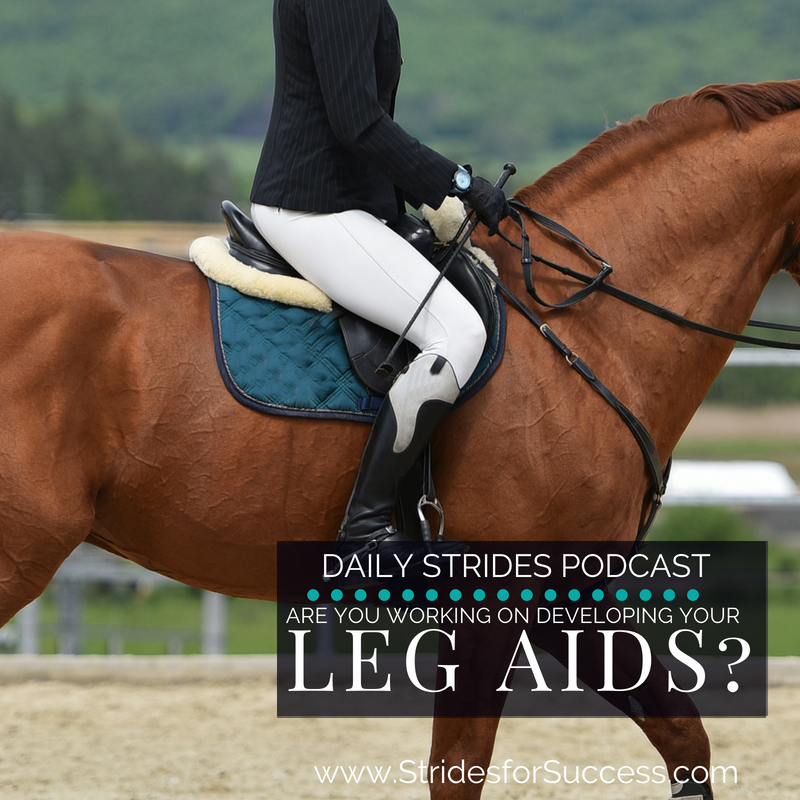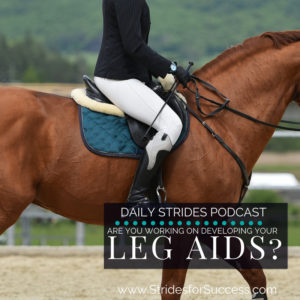
What this episode is all about & how it can help you:-
- Become more respectful with your legs & how it will help the overall conversation
- Understand why how you apply the aid is so important
- The difference between ‘loud aids’ and ‘quiet aids’
- Develop your leg aids as a guide – not a crutch
Your legs make up such a huge part of the active conversation that happens between you and your horse when you’re in the saddle. You can use them to ask questions. They can be used to guide or direct your horse.
Yet, so many riders fail to recognise how important their legs are to the whole conversation; and how improving your overall control of your legs, can have a huge positive effect on everything else.
In this episode of the Daily Strides Podcast I will give you some ideas on how you can begin improving your leg aids, starting the very next time you are in the saddle.
“My horse is not responsive”…
One of the first statements riders say when we are working on their leg aids usually sounds a little like this. They bemoan the fact that their horse is either a little slow to respond to their leg aids – or blatantly disregards them!
I truly believe that responsiveness begins with the rider – and it begins when the rider shows respect to the horse in how they communicate with their aids.
Becoming more Respectful of Your Leg Aids
I feel it is really important as the rider that you show up as the team leader. Are you being respectful with your leg aids to begin with? Or are you using them to stay in the saddle (the vice grip effect!).
Or perhaps you are nagging. On and on and on and on. Horses, just like us, tend to begin ignoring the ‘dripping tap’ after a while. The ongoing ‘drone’ that never really has anything constructive to add to the conversation. This can often be described as ‘dead to the leg’.
I also respectful means becoming more thoughtful about how you are applying the aid. Huge kicks are not enjoyable for anyone involved.
If you horse is ignoring your leg aids, I suggest using a schooling whip directly behind the ‘ignored aid’ (your leg). It will help bring your horses attention to the missed aid, without the unpleasantness of big, awkward, rhythm breaking kicks! A simple ‘tap’ is a lot nicer than a huge kick.
Respectful also means only speaking when you have something to add to the conversation. Think of this next time you are in the saddle with regards to how you are using your leg aids.
How You are Applying Your Leg Aids
There are a lot of different ways you can communicate with your horse using your legs. If we think of asking your horse to move forward, it will almost feel like wrapping your legs around your horses tummy and lifting it up using your legs.
It is a ‘lift’ motion, which means that you also need to create space for that lift. This is where your seat aid connects with your leg aids. An allowing seat will create the space for your horse move into as he responds to your legs.
Turning your horse requires a different leg aid. Think of your legs rather being the guide as to where you would like your horse to go. The parameters that your horse can work within.
Loud Aids Versus Quiet Aids
I personally think that all aids can either be described as being loud or quiet. Some can fall into both categories depending on how they are used and who uses them.
Loud aids are the equivalent of ‘shouting’ at your horse. They are obvious – to the point where they are visible to people who are watching from the ground.
Quiet aids are the whispers. The secret conversation that goes on between horse and rider. Your seat is a good example of this – it should only really be ‘felt’ by you and your horse – not seen by other.
Overtime the conversation between you and your horse will become more refined and more quiet. Your leg aids will become quieter as your seat plays a bigger role. They will become more subtle.
The Relationship Will Change as You Both Develop
As you and your horse practice the conversation more and more together, it will improve. It has to.
It is just like the people in your life. The more time and energy you invest in building and developing the relationship, the more subtle you can communicate with those people. A glance or a shrug can mean so much if the person knows you and your way of communicating with them.
As you and your horse become more familiar and comfortable with each other, the conversation will develop further.
Your Legs as a Guide Rather than a Crutch
I really think that horses who ‘need’ the riders legs are created by riders who lack confidence to begin with. The rider feels that they can and have to control every little thing when it comes to riding and being in the saddle.
Please realise that as a rider, the only thing you can truly work on controlling is yourself. The greater control you have over yourself, the greater influence you will have over your horse.
Gripping with your legs in order to stay on, or to ‘keep the horse going’ or anything else for that matter is not what your legs are for as a rider. Focus on remaining balanced and equal in teh saddle and then ‘draping’ your legs around your horse.
Riders who want to control will end up literally holding the horse up, using their inside leg, through corners, bends, turns – and even on the straight.
Your Leg Aids Can Be Training Wheels Initially
Training wheels, or stabilizers as we called them, are the two additions put on the back wheel of a bicycle when someone is initially learning to cycle.
They only come into play when the bike leans or tips to a point where it is no longer stable and balanced. They force the bike back to centre, and allow the new cyclist to continue cycling.
Your legs should initially be the training wheels for your horse. They don’t keep him upright or balanced – but when he wanders off track a little, they help bring things back to where they should be.
Use your leg aids to ask the question. Then allow your horse to respond and only when he goes a little off track, rejoin the conversation again to bring things back where they should be.
This is how your horse learns to take responsibility for himself – and that is one of your biggest responsibilities as team leader :)
Next Time You Are in the Saddle…
Think about how you are using your legs to communicate with your horse.
- Are you being respectful?
- What about how you are adding to the conversation?
- Are you applying the aids themselves correctly?
- What about the timing, are you asking the right questions at the right time?
- Finally, are you consistently working on developing and refining your leg aids to take them from being ‘loud’ to subtle and quiet?
If you are interested in working with me further on this topic, here is your invitation to join me inside of Daily Strides Premium. You can begin today for just $19 and get instant access to a whole collection of lessons focusing on your leg aids.
Happy Riding
Lorna
Links mentioned in the episode:-
- Join Daily Strides Premium today for just $19
- Reschooling a Horse that is Dead to Your Leg
- The Relationship Between Your Inside Leg & Outside Rein
- How to Use Your Legs While Riding

